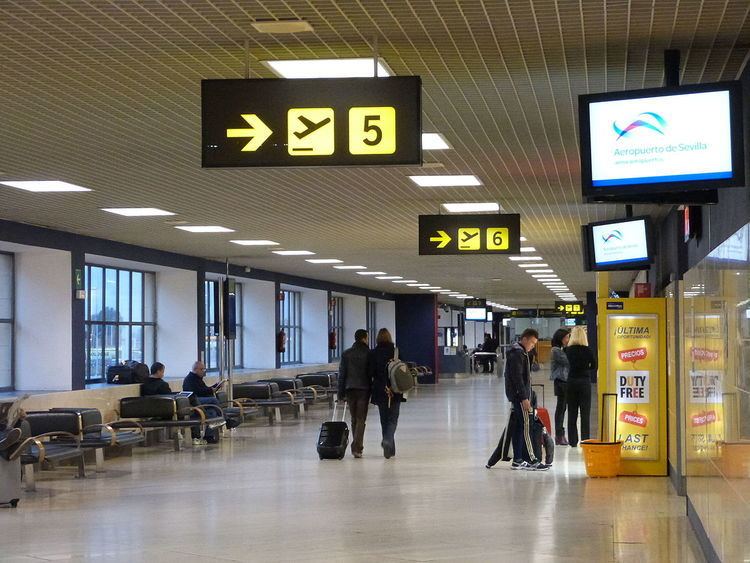Airport type Public Elevation AMSL 34 m / 112 ft Code SVQ | Operator Aena Aeropuertos Focus city for RyanairVueling Website aena.es Elevation 34 m Phone +34 954 44 90 00 | |
 | ||
Address A-4, Km. 532, 41020 Sevilla, Spain | ||
Seville airport landing vueiling airbus a320
Seville Airport (IATA: SVQ, ICAO: LEZL) (Spanish: Aeropuerto de Sevilla) is the sixth busiest inland airport in Spain. It is the main international airport serving Western Andalusia in southern Spain, and neighbouring provinces. The airport has flight connections to 42 destinations around Europe and Northern Africa, and handled 4,308,852 passengers in 2015. It serves as base for the low cost carriers Vueling and Ryanair. It is 10 kilometres (6.2 mi) east of downtown Seville, and some 110 kilometres (68 mi) north-east of Costa de la Luz.
Contents
- Seville airport landing vueiling airbus a320
- Seville airport bus
- Facilities
- History
- Public transport
- Incidents and accidents
- References
Seville airport bus
Facilities
Seville Airport is capable of handling six million passengers a year. There are 23 stands (all of them are self-maneuvering) of which 16 are remote, with 42 check-in desks and 16 boarding gates. Since its opening in 1991 Seville airport has undergone minor extension works. In 2013 opened the new car parking building of 5 floors.
History
In 1914, the first plane flying between the peninsula and Morocco landed at the improvised aerodrome of Tablada, which had been fitted out the previous year for an air festival. Following this, the municipal government of Seville handed over a plot of land measuring 240,000 m2 (2,600,000 sq ft) to the Military Aeronautical Society for the construction of an aerodrome. Work on the aerodrome began in 1915 and that same year it began to be used for training pilots and observers.
In 1919 the first commercial flights were operated between Seville and Madrid. The following year, an air postal service was established between Seville and Larache and in 1921, the first Spanish commercial service between Seville and Larache was set up. In 1923, various facilities such as hangars, workshops and premises were opened and approval was given for the construction of a municipal airport in Tablada at one end of the military aerodrome airfield, measuring 750 by 500 m (2,460 by 1,640 ft).
In April 1927, Unión Aérea Española established the air service Madrid-Seville-Lisbon. In February 1929, the Seville airport project was approved and in March, the Tablada aerodrome was opened to flights and air traffic. It was decided that this service would cease once the planned airport was constructed.
In 1929 the first flight was operated between Madrid and Seville and in 1930, this was extended to the Canary Islands. In February 1931, the service between Berlin and Barcelona was extended to Seville. In December 1933, LAPE began a service between Seville and the Canary Islands.
During the Spanish civil war, Seville became the arrival point for African troops, whilst Iberia served air transport with flights between Tetuán-Seville-Vitoria, Seville-Salamanca and Seville-Larache-Las Palmas.
In September 1945, works began on the Seville transoceanic airport, with the construction of runways 05/23, 02/20 and 09/27. One year later, it was classified as a customs point and runways 05/23 and 02/20 were asphalted. In 1948, a goniometer was installed, the runway lighting was completed, and the runways became known as 04/22, 18/36 and 09/27. In 1956, runway 09/27 was extended and runway 18/36 became a taxiway.
In 1957, works were carried out on the terminal building and the control tower. Seville Airport was then included in the Hispanic American Agreement for the installation of a supplies base. The facilities were developed near the threshold of 04, rendering the runway out of service.
In 1965 an Instrument Landing System was installed. Between 1971 and 1975, the terminal area was renovated, the apron was extended, a new terminal building was constructed and new access roads were developed.
In 1989, with a focus on the Seville Expo '92, the apron was extended, and a new access from the national motorway N-IV was opened; a new terminal building and a new control tower to the south of the runway were also built. On 31 July, the new installations were inaugurated.
Public transport
Urban Transport Line of Seville Airport Airport Express connects the bus station Plaza de Armas, in the center of the city with the airport. It has intermediate stops at strategic points of the city, including the AVE train station of Santa Justa. The whole trip takes approximately 40 minutes. Buses run from 04.30 till 00.45.
